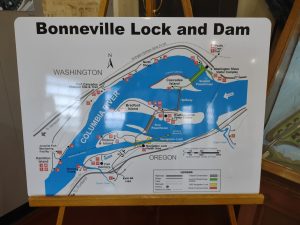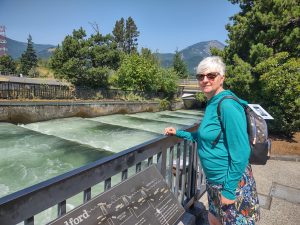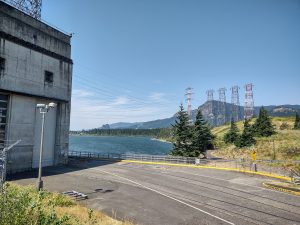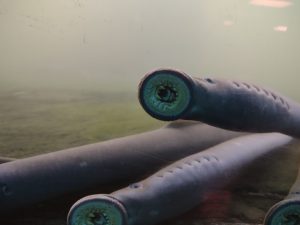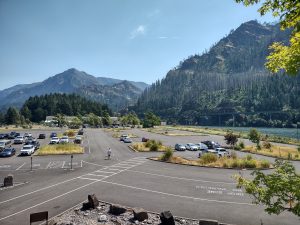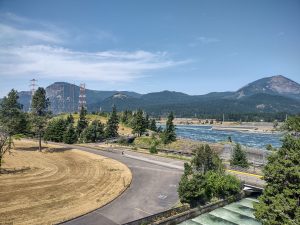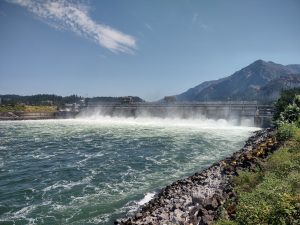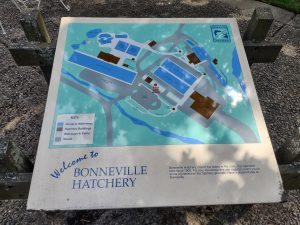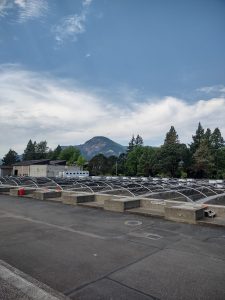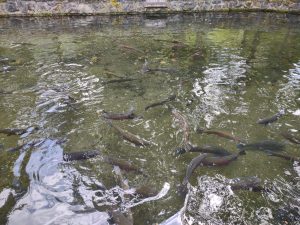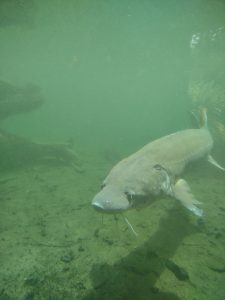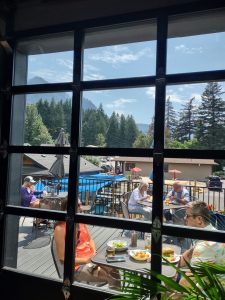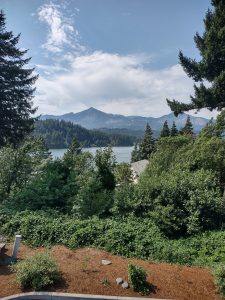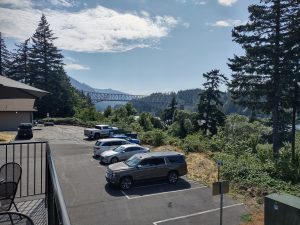Having learned at The Dalles dam that the Bonneville dam had more access to the dam itself, we drove there to see. On the way, we drove through Cascade Locks, where there had been a canal and lock to get around rapids, replaced by the Bonneville dam. On arriving at the Bonneville dam, the gate guard checked our car for guns and drones, neither allowed in the area.
The dam has four main parts. There are two power station dams, one spillway dam and a navigation lock raising/ lowering vessels 60 feet. There are three islands and the spaces between them are where the dams are built. At each power station dam, there is a collector that encourages fish traveling upstream to move across the dam face to fish ladders where they can continue upstream. The spillway dam lets the Army CoE manage river water level and coincidentally provides a downstream path for fish headed to the ocean. The configuration has changed since the dam was built in the 1930s.
The visitor center was on five levels. The bottom level had viewing panels for the fish ladder and the counting room. Fish don’t have to jump each ladder; there are passages where they can simply swim up to the lakes above. In the counting room, employees literally count the number of each species of fish passing up the fish ladder. Deadly boring to me, but I thought it might make a fantastic job for the hyper-focus sometimes accompanying autism. There are museum-like exhibits on level four and an observation area on level five.
We went down to level one, then walked over to the number 1 power station dam. What you see in the powerhouse is the electrical part of the power turbines. Below the stator/ rotor are the turbine blades turned by water falling from the dam lake to the output. The turbines, refurbished relatively recently in the dam’s history, now have adjustable pitch propellers with variable geometry blades. This took Jim back to his Navy days designing props and working in shipyards! The new designs have improved the through-turbine fish survival rate into the mid 90% range.
We went back to the fish viewing area. We found one window with lampreys sucking onto the window. Lampreys are not eels but are among the oldest of animal species. In the ocean, they are parasitic on other fish. We also saw large steelhead trout and salmon, probably coho. The fish counters identify fish in an instant and click their keyboard to indicate species, sex and whether hatchery raised or wild.
We ascended to the observation area and enjoyed the views. We drove a little way out on one of the islands and took better pictures of the spillway dam.
From there we drove to the fish hatchery, used to replace fish that would have been born in the areas that the dam displaces. We saw fingerling salmon in some ponds, big rainbow trout in a viewing area and white sturgeon up to six feet long in another viewing area. The hatchery areas where small fish are raised are covered by netting to prevent bird from eating all the fish!
Having seen enough, we drove back to Cascade Locks and had lunch at the Thunder Island brewing company. Nice salmon rice bowl and blackened chicken sandwich, accompanied by the Thunder Island juicy and 140 IPAs.
Both the Bonneville Dam and the Thunder Island place give views of Table Mountain (Washington side of the river). Sometime in about the 1500s, one whole face of the mountain fell into the river, creating some of the land mass around the Bonneville Dam and coincidentally named the Bonneville Slide. One wonders when the next huge slide will happen. We don’t want to be there when it does!
Back to The Dalles, where we bought corn and peaches at Evans fruit stand. Having had a huge late lunch, we supped simply on peaches and caprese salad.


